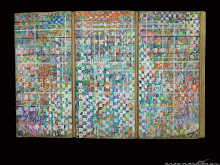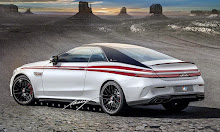It Was the Best of Times, It Was the Worst of Times
The cover of this mid-Fifties Life magazine shows Shirley Jones, star of the then-new movie, Carousel. Shirley not only played David Cassidy's mother in the Partridge Family TV show, she was his real-life step mother, having married Jack Cassidy in 1956. Interestingly, the wear-and-tear of this almost 55 year old magazine, shows that an extra layer of magenta-ink/varnish was used to make this image even more "sugary" sweet and warm. Notice the edges where the darker overlying inks have worn away, revealing the extra layer of magenta. This issue is dated February 6th, 1956, which was my grandmother's 61st birthday, and approximately 15 months before I graced the Earth with my presence, lol.

Who knew that CBS, The Columbia Broadcasting System, had a division that built TVs in the Fifties? I remember the days when picking out a new TV meant having a choice of actual wooden cabinetry. We had some absolutely beautiful television sets when I was growing up. Even our stereo was in a huge wooden cabinet, and included a record player and AM/FM/Weather Band radios, and storage space for the records. It must have been six feet long and 2 feet wide, a very real piece of furniture that needed to be taken into account in the design/decoration of the livingroom. Notice the pretty white women used to sell these American television sets. Reality and diversity had not begun to make much-needed inroads into the advertising world yet. More on this Fifties reality below.

OK. Whatever happened to this wall refrigerator and freezer? Apparently GE designed this unit to take the place of eye-level kitchen cabinets. I've never seen one in person, and have never even seen an ad for one until I came across this one. I'm fascinated by the concept! How very Mid-Century Modern to build the refrigerator into the space instead of having it just standing up taking space.
This is an ad for General Motors, not just Chevrolet, touting the corporation's new four-door pillarless bodystyle. This Bel-Air Sports Sedan's Sierra Gold/Adobe Beige two-tone color combination, was one of Chevy's most popular, and can be seen today at almost any car show featuring Tri-Five Chevys, the nickname for the '55-'57 generation of Chevys.

Way before one of my favorite James Bond movies was filmed, Diamonds Are Forever, there was this ad for "A Diamond is Forever." Featuring the Love Letter, painted for the De Beers Collection by Herbert Saslow, the actual shiny gems are relegated to the bottom left, and appear almost as an afterthought. The diamond shapes in the painting are wonderful, the sentiment is lovely, and I can't help but think this would never be approved today. The product must always be front and center, lest the message be lost on America's less-than-brilliant general population. I know, snarky, but the dumbing down of America is just about complete in my opinion. If a message isn't immediately understood by someone with a 5th grade reading comprehension level, it's no good today.

It wouldn't really be an artandcolour post without a Lincoln in it somewhere, right? Except, this phenomenally gorgeous Continental Mark II isn't technically a Lincoln at all. For this limited production, ultra luxury coupe, FoMoCo added an entire division, the Continental Division, to its corporate stable. The 4-pointed star logo was created for this Continental. A short couple of years later, the division was folded into the Lincoln-Mercury family, and by '61 would be selling the classic suicide door Lincoln Continental sedan.
And Think of Mother! That's the text in this ad for Bendix's new electric clothes dryer. I mean, my gosh, hanging the clothes in the basement means Dad and Sonny-boy are terribly inconvenienced in their quest for All-American recreation activities. The two-color layout is very eye-catching though, as well as less expensive than a four-color ad, no matter how sexist the marketing statement was.
This ad for the '56 Oldsmobile 4 door pillarless hardtop, a Holiday in Olds-speak, has wonderful typography. The horizontally-scaled type for "The Car with the Power Personality" works beautifully with the rocket flying through it, and the wonderfully vertically-scaled "88" is a perfect way to lead your eye to the paragraph of text on the far right. These were the years of the Rocket 88s, and the space-age theme was repeated on the engine, the dashboard, the corporate logos on the hood and steering wheel, and would prove to be a long-lasting Oldsmobile theme, right on through to the 1970s.

Now lest we start to get all warm and fuzzy with these "wonderful" glimpses at American life in the 1950s, LIFE also had this story on the "South Rises Again" in a campaign to delay integration. Notice all of the middle-aged white men from all walks of their limited lives. In the top photo which goes across the spread, there is a lawyer, a farmer, a couple of U.S. Congressmen, two teachers, three U.S. Senators, an insurance executive, and a state representative. Governors of the southern states are represented in the lower photos, There is a photo of a Pontiac Catalina coupe with "anti-negro" slogans all over it, carrying segrationists from Nashville.
The story runs six pages, and includes a photo of a closing prayer at a citizen's council meeting in Jackson, Mississippi. The Presbyterian minister Albert Sydney Johnson, named for a Confederate general, gave the Benediction. A President-Emeritus of Bellhaven College declared: "Segregation is not a child of race prejudice . . . segregation can be defended because it is the only reasonable and practical means to prevent racial intermarriage."
Yes, "racial intermarriage" was a large part of their racism. I'm sure cries of "this will ruin the sanctity of marriage" were heard throughout the cracker South. As incredibly hard as it is to believe, it was not legal in all fifty United States for blacks and whites to marry until 1967, with the Supreme Court case, Loving v. Virginia making it a Federal law (ironic court case name, right?). Something tells me with the radical right-wing Roberts Supreme Court of today, they would find a way to decide the case differently.
Sound familiar to anyone today? Today's Focus on the Family, Family Research Council, Concerned Women for America, and other homophobic hate groups exist only to "prevent the ruin of the sanctity of marriage" but today they rail against gays instead of blacks. At least today we have the internet and we have civil rights attorneys around the world working on our behalf. And we have the Southern Poverty Law Center calling out these hate groups for what they really are.





















































